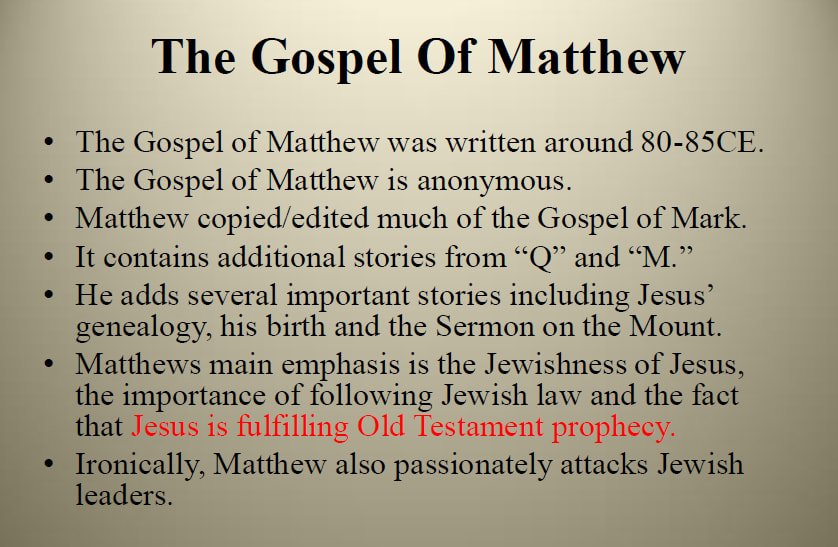
Matthew the Apostle, also known as Saint Matthew and possibly as Levi, was, according to the New Testament, one of the twelve apostles of Jesus. But Matthew did not write the Gospel attributed to him:
As Jesus passed by from there, he saw a man called Matthew sitting at the tax collection office. He said to him, “Follow me.” He got up and followed him. (Matthew 9:9)
Did “Matthew” write this about himself? Why then didn’t Matthew write for example: “he (Jesus) saw ME, and my name is Matthew. I was sitting at the receipt of custom…” etc.
Such evidence can be found in many places throughout the New Testament. Granted, it may be possible that an author sometimes may write in the third person, still, in light of the rest of the evidence that we shall see throughout this book.
As he sat in the house, behold, many tax collectors and sinners came and sat down with Jesus and his disciples. (Matthew 9:10)
Philip; Bartholomew; Thomas; Matthew the tax collector; James the son of Alphaeus; Lebbaeus, who was also called Thaddaeus;(Matthew 10:3)
Regarding the Gospel of Matthew, the Encyclopedia Britannica says:
“Although there is a Matthew named among the various lists of Jesus’ disciples, more telling is the fact that the name of Levi, the tax collector who in Mark became a follower of Jesus, in Matthew is changed to Matthew. 𝗜𝘁 𝘄𝗼𝘂𝗹𝗱 𝗮𝗽𝗽𝗲𝗮𝗿 𝗳𝗿𝗼𝗺 𝘁𝗵𝗶𝘀 𝘁𝗵𝗮𝘁 𝗠𝗮𝘁𝘁𝗵𝗲𝘄 𝘄𝗮𝘀 𝗰𝗹𝗮𝗶𝗺𝗶𝗻𝗴 𝗮𝗽𝗼𝘀𝘁𝗼𝗹𝗶𝗰 𝗮𝘂𝘁𝗵𝗼𝗿𝗶𝘁𝘆 𝗳𝗼𝗿 𝗵𝗶𝘀 𝗚𝗼𝘀𝗽𝗲𝗹 𝘁𝗵𝗿𝗼𝘂𝗴𝗵 𝘁𝗵𝗶𝘀 𝗱𝗲𝘃𝗶𝗰𝗲 𝗯𝘂𝘁 𝘁𝗵𝗮𝘁 𝘁𝗵𝗲 𝘄𝗿𝗶𝘁𝗲𝗿 𝗼𝗳 𝗠𝗮𝘁𝘁𝗵𝗲𝘄 𝗶𝘀 𝗽𝗿𝗼𝗯𝗮𝗯𝗹𝘆 𝗮𝗻𝗼𝗻𝘆𝗺𝗼𝘂𝘀.” [Biblical Literature and Its Critical Interpretation, The Gospel According to Matthew]
The passing years do not make it any plainer who actually wrote our Greek Matthew. Papias records, as quoted by Eusebius, that Matthew wrote the Logia of Jesus in Hebrew (Aramaic). Is our present Matthew a translation of the Aramaic Logia along with Mark and other sources as most modern scholars think? If so, was the writer the Apostle Matthew or some other disciple?There is at present no way to reach a clear decision in the light of the known facts. (Commentary by A.T. Robertson)
According to the Gospel of Matthew (chapter 9), Matthew the tax-collector was a Palestinian Jew. As such, his native language was Aramaic. That makes it highly unlikely that he could have written this book.
To begin with, apart from the books written by the extremely highly literarily elite Josephus, we don’t have any literary books composed in written Greek by any Palestinian Jews of the first century. Zero.
Josephus did not comment on the writings of the Christians. He likewise did not comment on the role of Greek or Aramaic usage in Galilee or Judea. He does make one comment about his own use of Greek:
…..𝗜 𝗵𝗮𝘃𝗲 𝗮𝗹𝘀𝗼 𝘁𝗮𝗸𝗲𝗻 𝗮 𝗴𝗿𝗲𝗮𝘁 𝗱𝗲𝗮𝗹 𝗼𝗳 𝗽𝗮𝗶𝗻𝘀 𝘁𝗼 𝗼𝗯𝘁𝗮𝗶𝗻 𝘁𝗵𝗲 𝗹𝗲𝗮𝗿𝗻𝗶𝗻𝗴 𝗼𝗳 𝘁𝗵𝗲 𝗚𝗿𝗲𝗲𝗸𝘀, 𝗮𝗻𝗱 𝘂𝗻𝗱𝗲𝗿𝘀𝘁𝗮𝗻𝗱 𝘁𝗵𝗲 𝗲𝗹𝗲𝗺𝗲𝗻𝘁𝘀 𝗼𝗳 𝘁𝗵𝗲 𝗚𝗿𝗲𝗲𝗸 𝗹𝗮𝗻𝗴𝘂𝗮𝗴𝗲, 𝗮𝗹𝘁𝗵𝗼𝘂𝗴𝗵 𝗜 𝗵𝗮𝘃𝗲 𝘀𝗼 𝗹𝗼𝗻𝗴 𝗮𝗰𝗰𝘂𝘀𝘁𝗼𝗺𝗲𝗱 𝗺𝘆𝘀𝗲𝗹𝗳 𝘁𝗼 𝘀𝗽𝗲𝗮𝗸 𝗼𝘂𝗿 𝗼𝘄𝗻 𝘁𝗼𝗻𝗴𝘂𝗲, 𝘁𝗵𝗮𝘁 𝗜 𝗰𝗮𝗻𝗻𝗼𝘁 𝗽𝗿𝗼𝗻𝗼𝘂𝗻𝗰𝗲 𝗚𝗿𝗲𝗲𝗸 𝘄𝗶𝘁𝗵 𝘀𝘂𝗳𝗳𝗶𝗰𝗶𝗲𝗻𝘁 𝗲𝘅𝗮𝗰𝘁𝗻𝗲𝘀𝘀; 𝗳𝗼𝗿 𝗼𝘂𝗿 𝗻𝗮𝘁𝗶𝗼𝗻 𝗱𝗼𝗲𝘀 𝗻𝗼𝘁 𝗲𝗻𝗰𝗼𝘂𝗿𝗮𝗴𝗲 𝘁𝗵𝗼𝘀𝗲 𝘁𝗵𝗮𝘁 𝗹𝗲𝗮𝗿𝗻 𝘁𝗵𝗲 𝗹𝗮𝗻𝗴𝘂𝗮𝗴𝗲𝘀 𝗼𝗳 𝗺𝗮𝗻𝘆 𝗻𝗮𝘁𝗶𝗼𝗻𝘀….
— Antiquities of the Jews 20,11.2
And as I will be showing in a moment, this Gospel was certainly composed in Greek.
The vast majority of Palestinian Jews in this period were illiterate – probably around 97%. The exceptions were urban elites. There is nothing to suggest that Matthew, the tax collector, was an urban elite who was highly educated.
_________________________________________
References:
2.” Who were author of Bible? ” Article by Rami Abdallah and Qais Ali;
3.The Encyclopedia Britannica – Biblical Literature and Its Critical Interpretation, The Gospel According to Matthew
4. “Was the Author of Matthew?” Article by Professor Bart D Ehrman.